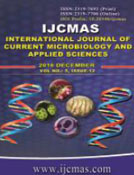


 National Academy of Agricultural Sciences (NAAS)
National Academy of Agricultural Sciences (NAAS)

|
PRINT ISSN : 2319-7692
Online ISSN : 2319-7706 Issues : 12 per year Publisher : Excellent Publishers Email : editorijcmas@gmail.com / submit@ijcmas.com Editor-in-chief: Dr.M.Prakash Index Copernicus ICV 2018: 95.39 NAAS RATING 2020: 5.38 |
To describe the microbiological profile of diabetic foot infections and what is the most common microorganism and to determine if the IL 6 can be used as a predictor of the diabetic foot infection. The study included 80 patients with diabetic history attended to the outpatient clinic of Diabetic foot, Internal specialized hospital, Mansoura University. 60 patients were the study group and 20 were the control group over a period from February 2015 to January 2016. Samples were cultured and identified microbiologically. The samples were measured fo the IL6 by ELISA. The antibiotic sensitivity test was done. Data for clinical presentation, bacteriology and management were collected. Statistical analysis was done. 80 patients were included. 60 patients were with infected foot lesions, 7 with uninfected lesions, 7 have diabetes only with lesion and 6 were normal person. Gran negative bacteria were more common than Gram negative bacteria. Klebsiella species were the commonest. Meronem was the most effective antibiotic for the Gram negative and Gram positive bacteria. There was a significant relation between the measured IL6 and the study group than the control group but not with the different microorganism pattern. Gram negative bacteria were the most common isolated bacteria from the diabetic foot infection. IL6 can be used as a predictor of the diabetic foot infection.
 |
 |
 |
 |
 |